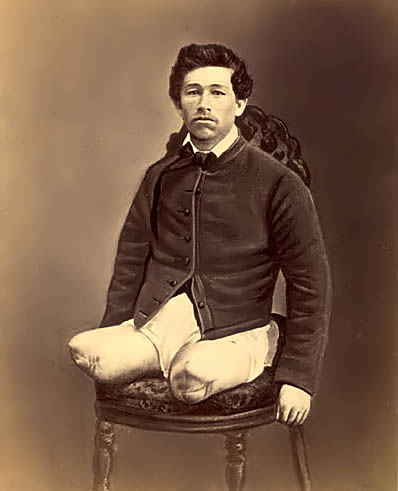 |
| Unknown |
Now you know if I can squeeze an appropriate song I like into a post I will do it - especially a Misfits song. Today's song is the Misfit's "Death Comes Ripping" and I included a more rare, but still very feral, version by Samhain to boot!!
What you are looking at below is something that likely caused a lot of pain in it's time but also potentially saved some lives. It is an amputation bone saw circa 1950. Despite it's antiquity this
amputation saw features some nice design features that would have facilitated as clean and straight an, ahem, amputation as possible. What I am referring to, and what I highlight in the pic below, are the recessed hollowed out portions between every eight or so serrations.
Also take note of the circular bulb that they end in. This feature is also found in modern day circular wood saws and are called expansion slot base holes. Their description via carbide processors:
Expansion slots strengthen and lengthen the life of the cutting serration.What happens is that as the cutting tips experience stress and pressure the expansion slots allow excessive forces to distribute throughout the body of the saw. And if you are woodworker trying to make a straight cut or a Civil War doctor field dressing a wounded soldier by amputating their musket bullet demolished tibia the expansion slots allow you to make straighter, cleaner, and more efficient cuts.
A recent paper Developmental and evolutionary novelty in the serrated teeth of theropods (Brink et. al.) July 2015 Scientific Reports link shows that this cutting innovation did not first arise on the Civil War battlefield or in the Lowes hardware section but was endemic to the most successful radiation of large bodied terrestrial predators ever - the theropods.
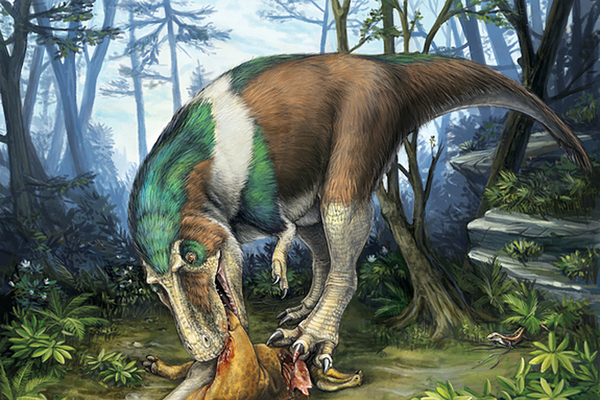 |
| Danielle Dufault (c) used w/permission |
What Kirstin Brink did - which I can imagine is painstakingly difficult - is to take thin sections of the serrations on various theropod teeth. Now, it is not big news to most that theropod teeth have serrations - ziphodont dentition - and it has even been known that close analysis of the space between serrations reveals a distinctive gap. Referred to in this paper as "deep interdental folds" they were previously interpreted as a feature that occurred epigenetically (i.e. during the working life of the tooth) to mitigate stresses imposed on the tooth but Brink's work reveals different. Analysis of teeth not yet erupted found that these interdental folds were already in place before the tooth experienced usage. The deep folds were also found on both the mesial and distal side of the tooth. Altogether a strong argument that this feature is nested deep within theropods and arguably assisted in their trajectory as apex predators across the globe for an unparalleled amount of time.
"We proposed a developmental hypothesis that these are structures created when the tooth is first forming," Brink said. "It actually helps to deepen the serration within the tooth and strengthen the serration and tooth overall."
Theropod teeth were bolstered with respect to other predators like monitor lizards and sharks by not only these folds but by a layer of dentine. The "planned obsolescence" of shark/monitor teeth is in line with the short life span of their teeth as compared to large theropods - months as opposed to years. By simply the addition of the interdental folds theropods not only had relatively superior cutlery in their jaws but maintained a distinct adaptive advantage over other ziphodont predators that must constantly replace teeth. With a more thrifty tooth replacement strategy all that valuable calcium and phosphorous that would go to tooth replacement could be used for other things - like growing a bigger skeleton or laying more eggs.
"What is so fascinating to me is that all animal teeth are made from the same building blocks, but the way the blocks fit together to form the structure of the tooth greatly affects how the animal processes food. The hidden complexity of the tooth structure in theropods suggests that they were more efficient at handling prey than previously thought, likely contributing to their success." Brink (link) via Sci-news.
Several lineages of theropods lacked or had modified deep interdental folds and Brink does not shy away from suggesting that the hypercarnivorous adaptations of theropods with such oral cutlery expanded their niche to include true bone consumption (i.e. not just in tyrannosaurids).
From the paper:
From the paper:
Now "bone crushing" is an interesting topic in theropod diet. Personally, in light of this new tooth data, I would prefer the term bone slicing to describe theropods likely presumed style of cutting into bone (remember the bone saw). But the amount of bone consumption and direct utilization of bones by theropods is equivocal and controversial. Tyrannosaurids, especially T-rex, are well accepted as bone crunchers/consumers based on their robust skulls and likely preserved coprolites loaded with minced bone matter (Chin, 1998). But generally paleontologists have shied away from suggesting direct bone consumption in other more blade toothed theropods. See Chure 1996.
And what should attract your attention is the allosaur pubic foot with a chunk cleaved clean off. This is from one single bite and it should be stated that the pubic foot is, with the possible exception of the sacrum, the most massive bone in the theropod body. Whether this was intention or incidental this substantial damage to a robust bone by a Jurassic theropod discredits the notion that only late Cretaceous advanced tyrannosaurids were capable of bone breaking/consumption.
 |
| Morrison theropod tooth marks on bone likely targeting meat |
However a more recent survey of theropod bone interactions paints a more nuanced portrait of bone consumption by theropods (Hone, 2009).
Theropods were eating loads of bone they suggest - but it was primarily in the form of small/immature dinosaurs consumed in entirety and the bone largely digested. While I agree with the premise that loads of baby dinos were getting gobbled up I do not necessarily concur that adult or near adults were not also predated or at least that the concentration on babies here is a tad overstated (but that is another post). Both the Churee and Hone papers specifically mention a higher degree of bone utilization in Cenozoic mammalian faunas... BUT in K-selected mammalian communities a larger proportion of the standing meat crop would be locked up in adult bodies. Therefore a higher frequency of bone exploitation should be expected in mammalian communities - exactly what we see. But this observation does not mean theropods did not exploit bone to some extent... AND that Allosaurus pubic bone pictured above was bitten clean through though...
Theropods were eating loads of bone they suggest - but it was primarily in the form of small/immature dinosaurs consumed in entirety and the bone largely digested. While I agree with the premise that loads of baby dinos were getting gobbled up I do not necessarily concur that adult or near adults were not also predated or at least that the concentration on babies here is a tad overstated (but that is another post). Both the Churee and Hone papers specifically mention a higher degree of bone utilization in Cenozoic mammalian faunas... BUT in K-selected mammalian communities a larger proportion of the standing meat crop would be locked up in adult bodies. Therefore a higher frequency of bone exploitation should be expected in mammalian communities - exactly what we see. But this observation does not mean theropods did not exploit bone to some extent... AND that Allosaurus pubic bone pictured above was bitten clean through though...
What leaps out at me in the above list is the obvious dominance of North American dinosaurs esp. Allosaurus/Tyrannosaurus. These are some of the most well sampled formations around. Basically a lot of bone/theropod interaction might be getting overlooked.
Additionally, if you look at the above review of theropod/bone interactions coprolites are excluded for whatever reason. There is the famous Tyrannosaurus turd that Karen Chin - she of dino-coprolite fame - documented but what gets less attention is her work on a large putative theropod coprolite with numerous bone fragments titled Exploited twice: Bored Bone in a Theropod Coprolite From the Jurassic Morrison Formation of Utah, U.S.A. 2007 SEPM-Special Bulletin. (contact Chin or myself for pdf I don't think this one is on the interwebz)
Additionally, if you look at the above review of theropod/bone interactions coprolites are excluded for whatever reason. There is the famous Tyrannosaurus turd that Karen Chin - she of dino-coprolite fame - documented but what gets less attention is her work on a large putative theropod coprolite with numerous bone fragments titled Exploited twice: Bored Bone in a Theropod Coprolite From the Jurassic Morrison Formation of Utah, U.S.A. 2007 SEPM-Special Bulletin. (contact Chin or myself for pdf I don't think this one is on the interwebz)
This is a really cool paper because it shows insects - Chin suggest Dermestid beetles - boring into the bone in a large theropod fecal mass, likely for safety. Not only is that interesting ecologically for it's documentation of complex insect/dinosaur interactions but it can not be determined who got to the bone first. That is, did the theropod consume bone already infiltrated with insects borings (and therefore likely old bone) or did the insect exploit bone in the theropod feces for shelter (shelter is assumed because of shallow borings)?Now Chin does at one point lean towards it being more likely that the theropod exploited the bone after the insects drilled into them - which therefore implies the bone was likely a bit old. But she hedges her bets the other way - that the insect bored into the bone after the theropod defecated it.
What's also interesting is that, unlike what Hone above suggested with small dinosaur bones becoming largely absorbed upon digestion, these fecal masses were clearly full of obvious cortical bone among smaller bits.
What's also interesting is that, unlike what Hone above suggested with small dinosaur bones becoming largely absorbed upon digestion, these fecal masses were clearly full of obvious cortical bone among smaller bits.
We have to assume three possibilities; this theropod ate small dinos and the bone was not fully digested; it bit chunks of meat off a carcass and incidental bone was ingested; or this theropod targeted bone purposefully. It should also be noted that Chin in this paper recorded another theropod coprolite of similar bone composition and size nearby:
Of the possible culprits (Allosaurus, Ceratosaurus, Torvosaurus) none of these theropods are similar to tyrannosaurids in skull/dentition. Maybe you don't have to be especially robust in jaw to consume bone just have the right bone saw dentition that easily slices up parcels of bone small enough to be swallowed whole.
And I think here is where we really need to look at our semantics and the biases implied. When we say "bone crunching" what immediately springs to mind is the spotted hyena (Crocuta crocuta). But that is the mammal solution to consuming bones because they can chew a bit and have heterodont teeth/molars. Theropod mouths were like scissors. Shouldn't we expect a uniquely theropodian solution to bone consumption? Turns out we might already have a good candidate that hints at how theropods consumed bones via a modern day bone eating theropod, the Lammergeier/bearded vulture (Gypaetus barbatus).
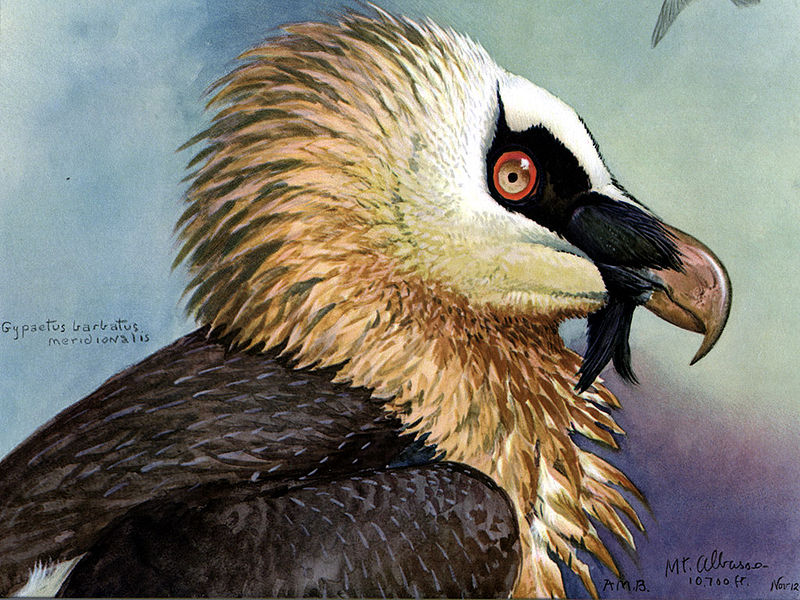 |
| A bone/marrow eating specialist the bearded vulture/lammergeier/ wiki |
This is a true bone specialist, more so than even spotted hyenas, with bones/bone marrow accounting for most of it's diet . It cracks open surprisingly large bones in its own jaws but principally drops bones from height when flying on rocky substrates and then eats all the shattered pieces swallowed whole. Take note that if you were a paleontologist of the future there would be no tell tale sign of bone use by bearded vultures because unlike hyenas they do not chew and crack bones. They swallow it all.
And this for me is part of the solution to the conundrum of why dinosaur bones are impoverished compared to mammal bones in being modified by predators. Mesozoic theropods were not dropping the bones from great height - but the bones that they were eating they were swallowing in large pieces (and crapping out the fecal masses full of chunks of bone everywhere). The way they were breaking down the bones was by surgically biting them into smaller, manageable sizes that were then swallowed whole. And they did the bone cutting with their uniquely strong and robust serrated dentition which was full in effect for even Coelophysis (Brink, 2015).
And then there is the strong possibility that dinosaurs, like modern birds, differ from mammals in the extent and distribution of red-blood cell making marrow locales. With dinos having highly pneumatized skeletons - especially sauropod vertebrae - the dietary cost/benefit of consuming these parts of the skeleton may have been too low. In dinosaurs there likely wasn't much marrow midshaft like in mammals but concentrated at the epiphyseal ends of bones like birds. From ornithology avian/circulatory system:
Maybe that chunk of pubic bone bit off the allosaur in Chures's paper was intentional and that was a localized area of bone marrow? Following from that thought it is possible that some of the red-blood production in dinosaurs took place outside of the bone and was outsourced to organs analogous or equivalent to the Bursa of Fabricus in modern aves - which is located in the cloaca of modern birds. Interestingly this get's me thinking again about that Allosaurus pubic bone cleaved off in the above paper by Chure, 1996. Maybe this organ was consistently targeted in dino carcass utilization.
And finally if the idea of optimal foraging strategy is invoked - in this case where a consumer of a substantial carcass concentrates their efforts on the spots with prime nutrition - large bones in dinosaurs might rank substantially low on a scale of nutrient value to other parts. So after the nutrient dense organs are consumed like the liver, intestines, lungs, kidneys, heart, reproductive organelles and then the fat deposits, and then onto the muscle... and finally perhaps after several days or weeks of feasting on a particularly large sauropod or saurolophine, now maybe the theropods is starting to look at the bones... But because of the hot, tropical climate much of the protein and fat within the bones has started to leach and bubble out of the bones - robbing them of the relatively little nutritive value that they had. And now that theropod - after feasting on the large carcass for several days or weeks already - now that theropod starts to really consider if the bones are even worth the effort? Might it be wasting more energy and time trying to wrest the relatively small amount of nutrients out of these bones and tie up its digestion with them? It's not so unusual - polar bears often only eat the fat of the seals they hunt and eschew the muscle meat. I can direct you to this very interesting link where they look at the carcass utilization by a pack of wolves on Isle Royal.
On optimal foraging strategy with regards to large carcass utilization in Isle Royal wolves:
"The idea is that when prey are relatively scarce it pays, obviously, to eat all that you can kill. However, when prey are relatively easy to catch, it pays to eat only the good parts (or perhaps leave behind the least choice parts). It may take more effort than it is worth to chew and digest the last bits of low quality scraps that remain after most of the carcass has already been eaten."
What is a bit of a paradox is the realization of robust tyrannosaurids sometimes being dainty eaters delicately stripping the bone off of carcasses - though they had the arsenal to eat the whole bone - and other theropods less orally equipped to consume substantial amounts of bone doing just that - such as the above Morrison coprolites - probably Allosaurus, Ceratosaurus, or Torvosaurus - (Chin, 2007), the cleaved Allosaurus pubic bone (Chure, 1996), and dromaeosaurs swallowing azdharchid bones (Hone, 2012). Clearly a more nuanced portrait of theropod bone utilization is called for. By invoking optimal foraging strategy, where marrow occurs in bird bones, and theropod tooth design I have outlined my meta-analysis of what was most likely going on with theropod bone use and the strange, sometimes seemingly discordant signal we receive from the fossil record sits more well with me.
Mammals show a stronger signal than dinosaurs for bone consumption due to an interplay of the following factors:
a) Differential exploitation of adult animals in respective communities, with mammal predators more biased towards adult carcasses in k-strategist communities (few young which mature quickly) versus theropods concentrating on growing and immature dinosaurs in these r-selected communities (many young which mature slower). Therefore much of the biomass is locked up in adult bodies in mammal communities and would therefore have been under relatively more frequent predator utilization both alive and dead. And being larger these mammal modified bones would benefit from preservational bias favoring their input into the fossil record, Generally in line with Hone, 2012 (although I think the notion of baby killing specialists is a bit overstated).
b) Relative cost/benefit of exploiting bone in respective communities. Mammals are well known for rich, fatty bone marrow in shaft of long bones. From what we know of bird marrow distribution their marrow is more patchily distributed. Certain dinosaur bones - especially pneumatized - may have generally been ignored unless dire environmental conditions encouraged utilization. Even tyrannosaurids - which unequivocally had the arsenal to crunch large bones - were sometimes delicate feeders and did not willy-nilly smash and eat all parts of a carcass. Bone may have often been a last resource and often ignored when there was other preferable pieces available to harvest. And in especially large carcasses by the time theropods got to the bone much of the good stuff (fats, proteins) may have leaked away making the bones further undesirable.
c) Mammals and theropods differ in their capacities to swallow large parcels of food. Theropods showing several distinct advantages in bolting large pieces of food such as large mouth and gape, expandable gular region, and ability to slightly "bow" out lower mandible in some lineages. This would allow both whole small dinosaurs/infants and large bones to be swallowed whole. Is supported by the observation of large chunks of bone in dinosaur coprolites (the more nutritious fats/proteins already sequestered in digestion), comparison to modern bone specialist avian theropods (bearded vultures), and preservation of large azhdarchid pterosaur bones in a dromaeosaur (Hone, 2012).
d) With the exception of possibly large tyrannosaurids there was probably little "bone crunching" in theropods directly analogous to hyenas. Instead, when bone was exploited, it was simply sawed off - via their advanced cutlery - and swallowed whole. Compared to mammals this methodology would leave little trace on the skeleton - since the evidence is swallowed whole - as opposed to mammals where bones are thoroughly chewed and crushed up but not always entirely consumed. But again, as discussed above in b, dinosaur bone was likely a relatively inferior food resource than mammal bone and therefore did not rank as high relatively in dinosaur carcass utilization. So mammal usage of bone is likely relatively higher. And this is consistent with the pattern of bone utilization seen in the respective dinosaur/mammalian communities and also large chunks of bone in theropod feces.
e) Never the less theropods, even non-tyrannosaurids, had the ability to saw off bone from large carcasses. This is supported by the cleaved off chunk from the allosaur pubic boot (Chure, 1998), the bone riddled coprolites dating to the Jurassic Morrison (Chin, 2008), and the work of Brink et. al. (2015) documenting novel features in theropod serrations suggestive of a relatively more robust and efficient cutting arsenal in theropods than generally appreciated.
And finally a long standing, but to our eyes cryptic, tradition of bone consumption in theropods throughout the whole of the Mesozoic just makes more sense. I am a firm follower of the dictum that "nature abhors a vacuum" and it is simply incongruous that theropods would >only< start targeting large bones with the advent of large tyrannosaurids in the late Cretaceous.
Riffing on this topic I decided to depict some theropod carnage highlighting some theropod bone sawing action. And yes dino carnage is a little over done but I feel like I have a special knack for it and when I do it I give it the Grand Guignol treatment. But not with a tyrannosaur - but with Carcharodontosaurus, Mr. Shark tooth himself. I think carcharodontosaurids get a little overshadowed by the tyrant lizards. It is a shame because they were nasty, brutish thugs and I would not be surprised if they had devised one of the most crippling bites around. What I am intrigued by in this family are those dorsal spines on the back. I wonder if they had a specialized musculature that rocked those massive heads back and forth like a saw (future post)? And then their shark like teeth are pretty impressive too. You don't have to read too many shark attack incidents to come across bone/limbs/torsos getting completely sawn off by sharks (not crushed!! It is an obvious homage to Robert Nicholl's 2x Death piece which recently spawned it's own scientific paper, Now I discussed why I think that paper had some flaws (no where in their analysis to they account for leg/caudal musculature assisting in the lift) but it still an iconic image. I just want to change it with respect to what happens when carch jaw meets titanosaur flesh. Sorry sauropod fans this is not one you might like... but sometimes you gots to remember where the food chain ends.
And if you think reading this was as enjoyable as that 3$ cup of starbucks you got today consider supporting me on Patreon.
And finally if the idea of optimal foraging strategy is invoked - in this case where a consumer of a substantial carcass concentrates their efforts on the spots with prime nutrition - large bones in dinosaurs might rank substantially low on a scale of nutrient value to other parts. So after the nutrient dense organs are consumed like the liver, intestines, lungs, kidneys, heart, reproductive organelles and then the fat deposits, and then onto the muscle... and finally perhaps after several days or weeks of feasting on a particularly large sauropod or saurolophine, now maybe the theropods is starting to look at the bones... But because of the hot, tropical climate much of the protein and fat within the bones has started to leach and bubble out of the bones - robbing them of the relatively little nutritive value that they had. And now that theropod - after feasting on the large carcass for several days or weeks already - now that theropod starts to really consider if the bones are even worth the effort? Might it be wasting more energy and time trying to wrest the relatively small amount of nutrients out of these bones and tie up its digestion with them? It's not so unusual - polar bears often only eat the fat of the seals they hunt and eschew the muscle meat. I can direct you to this very interesting link where they look at the carcass utilization by a pack of wolves on Isle Royal.
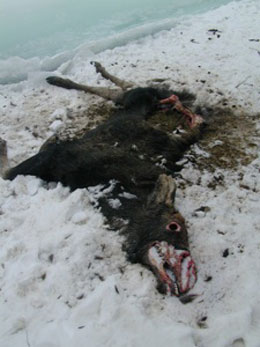 |
| differential carcass utilization in same pack of wolves |
"The idea is that when prey are relatively scarce it pays, obviously, to eat all that you can kill. However, when prey are relatively easy to catch, it pays to eat only the good parts (or perhaps leave behind the least choice parts). It may take more effort than it is worth to chew and digest the last bits of low quality scraps that remain after most of the carcass has already been eaten."
What is a bit of a paradox is the realization of robust tyrannosaurids sometimes being dainty eaters delicately stripping the bone off of carcasses - though they had the arsenal to eat the whole bone - and other theropods less orally equipped to consume substantial amounts of bone doing just that - such as the above Morrison coprolites - probably Allosaurus, Ceratosaurus, or Torvosaurus - (Chin, 2007), the cleaved Allosaurus pubic bone (Chure, 1996), and dromaeosaurs swallowing azdharchid bones (Hone, 2012). Clearly a more nuanced portrait of theropod bone utilization is called for. By invoking optimal foraging strategy, where marrow occurs in bird bones, and theropod tooth design I have outlined my meta-analysis of what was most likely going on with theropod bone use and the strange, sometimes seemingly discordant signal we receive from the fossil record sits more well with me.
Mammals show a stronger signal than dinosaurs for bone consumption due to an interplay of the following factors:
a) Differential exploitation of adult animals in respective communities, with mammal predators more biased towards adult carcasses in k-strategist communities (few young which mature quickly) versus theropods concentrating on growing and immature dinosaurs in these r-selected communities (many young which mature slower). Therefore much of the biomass is locked up in adult bodies in mammal communities and would therefore have been under relatively more frequent predator utilization both alive and dead. And being larger these mammal modified bones would benefit from preservational bias favoring their input into the fossil record, Generally in line with Hone, 2012 (although I think the notion of baby killing specialists is a bit overstated).
b) Relative cost/benefit of exploiting bone in respective communities. Mammals are well known for rich, fatty bone marrow in shaft of long bones. From what we know of bird marrow distribution their marrow is more patchily distributed. Certain dinosaur bones - especially pneumatized - may have generally been ignored unless dire environmental conditions encouraged utilization. Even tyrannosaurids - which unequivocally had the arsenal to crunch large bones - were sometimes delicate feeders and did not willy-nilly smash and eat all parts of a carcass. Bone may have often been a last resource and often ignored when there was other preferable pieces available to harvest. And in especially large carcasses by the time theropods got to the bone much of the good stuff (fats, proteins) may have leaked away making the bones further undesirable.
c) Mammals and theropods differ in their capacities to swallow large parcels of food. Theropods showing several distinct advantages in bolting large pieces of food such as large mouth and gape, expandable gular region, and ability to slightly "bow" out lower mandible in some lineages. This would allow both whole small dinosaurs/infants and large bones to be swallowed whole. Is supported by the observation of large chunks of bone in dinosaur coprolites (the more nutritious fats/proteins already sequestered in digestion), comparison to modern bone specialist avian theropods (bearded vultures), and preservation of large azhdarchid pterosaur bones in a dromaeosaur (Hone, 2012).
d) With the exception of possibly large tyrannosaurids there was probably little "bone crunching" in theropods directly analogous to hyenas. Instead, when bone was exploited, it was simply sawed off - via their advanced cutlery - and swallowed whole. Compared to mammals this methodology would leave little trace on the skeleton - since the evidence is swallowed whole - as opposed to mammals where bones are thoroughly chewed and crushed up but not always entirely consumed. But again, as discussed above in b, dinosaur bone was likely a relatively inferior food resource than mammal bone and therefore did not rank as high relatively in dinosaur carcass utilization. So mammal usage of bone is likely relatively higher. And this is consistent with the pattern of bone utilization seen in the respective dinosaur/mammalian communities and also large chunks of bone in theropod feces.
e) Never the less theropods, even non-tyrannosaurids, had the ability to saw off bone from large carcasses. This is supported by the cleaved off chunk from the allosaur pubic boot (Chure, 1998), the bone riddled coprolites dating to the Jurassic Morrison (Chin, 2008), and the work of Brink et. al. (2015) documenting novel features in theropod serrations suggestive of a relatively more robust and efficient cutting arsenal in theropods than generally appreciated.
And finally a long standing, but to our eyes cryptic, tradition of bone consumption in theropods throughout the whole of the Mesozoic just makes more sense. I am a firm follower of the dictum that "nature abhors a vacuum" and it is simply incongruous that theropods would >only< start targeting large bones with the advent of large tyrannosaurids in the late Cretaceous.
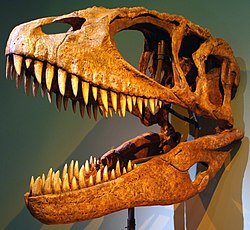 |
| Carcharodontosaurus credit Franko Fonseca. wiki |
Riffing on this topic I decided to depict some theropod carnage highlighting some theropod bone sawing action. And yes dino carnage is a little over done but I feel like I have a special knack for it and when I do it I give it the Grand Guignol treatment. But not with a tyrannosaur - but with Carcharodontosaurus, Mr. Shark tooth himself. I think carcharodontosaurids get a little overshadowed by the tyrant lizards. It is a shame because they were nasty, brutish thugs and I would not be surprised if they had devised one of the most crippling bites around. What I am intrigued by in this family are those dorsal spines on the back. I wonder if they had a specialized musculature that rocked those massive heads back and forth like a saw (future post)? And then their shark like teeth are pretty impressive too. You don't have to read too many shark attack incidents to come across bone/limbs/torsos getting completely sawn off by sharks (not crushed!! It is an obvious homage to Robert Nicholl's 2x Death piece which recently spawned it's own scientific paper, Now I discussed why I think that paper had some flaws (no where in their analysis to they account for leg/caudal musculature assisting in the lift) but it still an iconic image. I just want to change it with respect to what happens when carch jaw meets titanosaur flesh. Sorry sauropod fans this is not one you might like... but sometimes you gots to remember where the food chain ends.
And if you think reading this was as enjoyable as that 3$ cup of starbucks you got today consider supporting me on Patreon.
Cheers!!
papers
Brink, K.S. et. al. (2015) Developmental and evolutionary novelty in the serrated teeth of theropod dinosaurs.
Scientific Reports 5, article no. 12338, July 2015
Chin, K. et. al. (1998) A king-sized theropod coprolite Nature, 393
Chin, K. et. al. (2008) Exploited twice: bored bone in a theropod coprolite from the Jurassic Morrison formation of Utah, U.S.A. Sediment-Organism Interactions: A Multifaceted Ichnology SEPM special publications No. 88
Chure, Daniel J. et. al.(1996) Prey bone utilization by predatory dinosaurs in the Late Jurassic of North America, with comments on prey bone use by dinosaurs throughout the Mesozoic. December 1996, GAIA
papers
Brink, K.S. et. al. (2015) Developmental and evolutionary novelty in the serrated teeth of theropod dinosaurs.
Scientific Reports 5, article no. 12338, July 2015
Chin, K. et. al. (1998) A king-sized theropod coprolite Nature, 393
Chin, K. et. al. (2008) Exploited twice: bored bone in a theropod coprolite from the Jurassic Morrison formation of Utah, U.S.A. Sediment-Organism Interactions: A Multifaceted Ichnology SEPM special publications No. 88
Chure, Daniel J. et. al.(1996) Prey bone utilization by predatory dinosaurs in the Late Jurassic of North America, with comments on prey bone use by dinosaurs throughout the Mesozoic. December 1996, GAIA
Hone, D.W.E. et. al. (2012) Pterosaurs as a food source for small dromaeosaurs. Paleogeography, Paleoclimatology, Paleoecology
Hone, D., & Rauhut (2009) Feeding Behavior and bone utilization by theropod dinosaurs Lethaia DOI
Support me on Patreon.
Like antediluvian salad on facebook. Visit my other blog southlandbeaver.blogspot
Watch me on Deviantart @NashD1. Subscribe to my youtube channel Duane Nash.











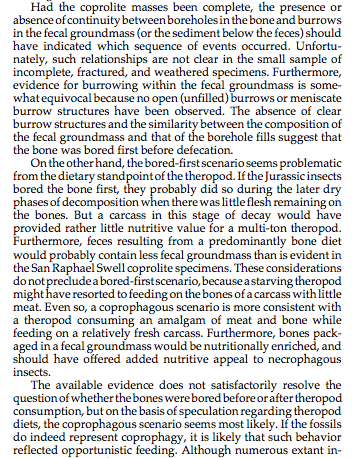





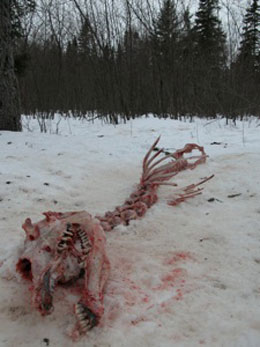





9 comments:
Well this is astonishing. I always wondered why such massive Theropods like Allosaurus and the ilk had relatively weak bite forces, but seeing as how their jaws were basically like gigantic saws, I guess they didn't need a Tyrannosaurs bite force. Btw, this doesn't (necessarily) have to do with this post, but do you think I could E-mail you on occasion for some scientific advisory? I can't seem to find your E-mail on your blog, so I was wondering if you could tell me it (if you're okay with me asking you once in a while about Dinosaur paleobiology and etc.).
Yes that is exactly the point. Just as you don't 1000's of lbs of force to saw a tree or bone neither did theropods. duanen8@gmail.com or you message me on fb BTW I am gearing up on a post reexploring feeding in allosaurus so stay posted!!
Sweet. I always love how "average" Allosaurus looks, yet it has a rather strange method of prey capture...and the fact that it basically had a monopoly on the Morrison formation (poor Torvosaurus and Marshosaurus never get the attention they deserve). I'll try and E-mail you a question or two sometime soon. Have a nice day (or night, it's like 1:30 AM where I am).
Another blow against tyrannosaur fanboys! High bite force is redundant!
I agree Bk Jeong it's high time the t-rex dominion get's taken down a notch or two. I think I recall you saying some similar things on Witton's blog. Eventually I want to do some stuff on what tyrant lizards and why they went the route of high bite force but that is on my increasingly growing to do list.
Yeah.
High bite force? That only keeps you from sawing prey into ribbons.
The reason why Tyrannosaurs specialized in bone crushing may have to do with Ornithischian dinosaurs' bones being less pneumatic and may be more desirable for food source. Remeber that bone-crushing Tyrannosaurs were late(and restricted geographically) additions to Mesozoic, living where Ornithischians were major megafauna herbivores.
Good point. I will keep this in mind.
This is a ggreat post
Post a Comment